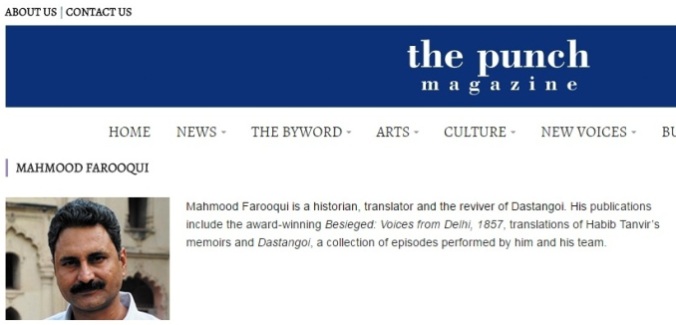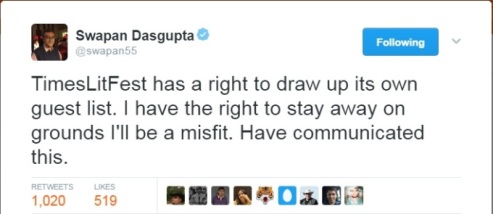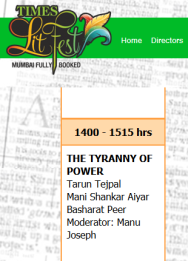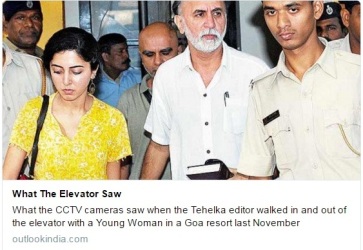Recently an article was published in The Punch Magazine (the revamped avatar of The Byword) titled “Dibai, the Qasba where Intizar Husain was born” profiling Intizar Husain, a significant fiction writer in Urdu of the 20th century from Lahore, on his first death anniversary.
No, neither the article nor the subject matter caught my attention, but I was perturbed by the identity of the writer of the article. On further investigation, I observed that apart from all other credentials of the author, it nowhere mentions that Mahmood Farooqi is also an incarcerated rapist.

Let me tell you that this is not new, is rather a systematic pattern, how the Khap-elites rehabilitate members of their ecosystem even if one is a convicted rapist serving a sentence in jail. Yes, the writer of that piece Mahmood Farooqui is a convicted rapist of a foreigner student and also the co-director of the movie Peepli Live.
Last October, William Dalrymple plugged an article titled “With prisoners as actors, filmmaker charged with rape directs play in Tihar” in a tweet smartly striking off the words from the headline “charged with rape” feeling proud of his rapist colleague:

It was countered here, calling it the standard template how a convicted rapist is quietly rehabilitated by ‘left-liberal elites.’ The next moment, the super liberal torch bearer of ‘freedom of expression’ blocked me on twitter.
Before I explore this further, let me first try to explain this pattern, how these feminists, women empowerment cheerleaders (the left-liberal mafia) cannot survive without their incestuous ecosystem of sexual predators and how they brazenly rehabilitate them into the mainstream despite them being accused/charged with gruesome sex crimes.
First let me remind you of the case of climate scientist Director General of TERI, R K Pachauri. When the complainant, a young researcher, refused to succumb to his “carnal and perverted desires,” she said, Pachauri responded by “threatening me that he will not give me any more work in his office and that I should leave TERI, or he will transfer me to some other division,” reported the Caravan.
R K Pachauri was first booked by Delhi Police on charges of outraging the modesty of a woman, molestation, stalking, sexual harassment and criminal intimidation and was also found guilty of similar charges by an internal complaints committee (ICC) of TERI. He is presently out on bail pending further investigation.
This detailed and investigated Caravan report, on Pachauri’s leadership at TERI and the sexual harassment case, suggests that he is supposedly a serial offender. Not one, not two but a third woman also alleged that she was sexually harassed by Pachauri while she was working as his secretary in 2008.
Given this, it is baffling to see TV debates or several subtle articles and pre-planned interviews the liberal mafia presented in his defense. Here, The Guardian published an article claiming that the embattled climate scientist has broken his silence in a series of interviews. This baffling defense was well countered here in this piece though.
In yet another perplexing incident, sexual harassment accused Tarun Tejpal was attempted to be rehabilitated among the ‘intelligentsia,’ because how can one understand the Idea of India without inputs from an accused molester, the left-liberal mascot.
Has anyone forgotten the Tejpal ‘fingertips’ story, one of Indian journalism’s most sordid scandals? The apology letter, the “recusing” of himself and the “penance of laceration” and the determination of the young colleague to expose his assault on her?
Twitter created ‘extraneous noises.’ A renowned columnist and author Swapan Dasgupta declined the invitation in protest and also wrote this searing piece: “Thank God For “Extraneous Noises“. It was in response to Bachi Karkaria, organizer of the literary festival, announcing on Twitter that Tejpal had been asked not to attend because the festival did not want “extraneous noise.”

It was interesting to notice that only the noise bothered Bachi Karkaria, and not the grievous charges.
The Times Literary Carnival invited Tejpal as a panelist on the subject of the “Tyranny of power.” Frankly, him being offered a platform like this in itself was “tyranny of power.” Manu Joseph, a journalist, was to be the moderator, with writer and now scriptwriter Basharat Peer and politician Mani Shankar Aiyar as the other participants.

Remember Tejpal’s defense in the sexual harassment case by the Delhi’s Khap-elites? It began with TV debates then articles on video footage of the corridor outside the lift where the assault happened..
In this The Outlook piece “What The Elevator Saw,” Manu Joseph, puts a question mark that hangs over what had happened inside the lift.

In the story, Mr. Joseph refers to Tejpal’s text message to the complainant, “the fingertips” as the “most destructive message a public figure had sent out in recent times.” In his view, “the message,” Mr. Joseph argues, “was either sent by a foolish rapist who was implicating himself through this evidence to a competent journalist whose area of particular interest was law and rape. Or perhaps, it was sent by a drunken man who thought he was flirting,” he concludes.
Yes, indeed, the same Manu Joseph who was picked as the moderator. Much before this, Bachi Karkaria herself wrote a piece in Times of India editorial ‘Trial by media‘ brazenly defending Tarun Tejpal.
Tejpal at the lit-fest was the most vivid proof that the Lutyens incestuous cabal is alive and kicking.
The festival director had defended the decision to include Tejpal on the panel and had told Scroll.in that, “The panel has nothing to do with his personal case. The case is not going to form any part of the discussion, and we have always found Tarun to be an articulate panelist.”
Some others felt that the principles of free speech and presumption of innocence (Tejpal himself apologized, publicly as well as privately before the matter became a police case ) could be applied to the decision to invite Tejpal. The ecosystem started to point out that TOI does have the right to invite him to their festival and that people can choose not to attend.
True. We have a legal system, and Tejpal is only an accused sexual offender and has not been convicted, yet. Inviting him to the LitFest reflects on the organizers, not Tejpal.
Many outraging about Tejpal being part of a Lit-Fest, do not understand that it’s routine in the Oxbridge-Khap-Cabal. Did you forget that the Taliban leader Mullah Zaeef was also invited to Tehelka’s Think2013 to tell the gathering how Taliban had equal rights for women and all? Fired from Penguin for the alleged sexual harassment, David Davidar finds a platform at a book fair.
This socially and intellectually influential Peepli Live co-director Mahmood Farooqui is one such incarcerated rapist, a ‘dastangoi’, the Khap elders are attempting to rehabilitate.
At first, the attempt was made to create confusion on the merits of the prosecution by continuously publishing articles defending the rapist. For example:
- Farooqui’s conviction a victory for rape victims, but does it taste all sweet?
-
Why the Mahmood Farooqui Judgment is Deeply Flawed
Several other such op-eds were surfacing almost every day to create doubt in public mind. But soon the details of the judgement started taking rounds in the public domain, contrary to the Lutyens Khap claims.
The special fast-track court sentenced Farooqui to seven years’ rigorous imprisonment for the rape. The judge observed, “… it can be safely held, that the testimony of prosecutrix, being truthful and credible when the prosecutrix was alone with the accused… the accused, taking advantage of the situation, raped the prosecutrix.”
Once again, very systematically, using book reviews and other “neutral” platforms that never mention the rape conviction, an attempt is being made to mainstream the fellow member.
On December 09, 2016, Scroll.in featured this: “A dastangoi tells the story of the Pakistani author Intizar Husain” of course without mentioning “other credentials” of the author Mahmood Farooqui.
On January 13, 2017 the Live Mint published a book review: “A Requiem For Pakistan—The World Of Intizar Husain” in which Mahmood Farooqui intersperses the story of Intizar Husain’s life with his own.
On January 16, 2017, The Hindu featured another noble side of this convicted rapist: “Tihar inmates wield the pen” It says that the idea of newspapers by and for Tihar inmates was put forward by several prisoners, prominent among them being Mahmood Farooqui, co-director of film Peepli Live.
One by one, articles are surfacing in India and also internationally on different sites and print, be it The Hindu, Scroll.in, or the Live Mint. None mention that he is a convicted rapist. Much more will follow. It is a standard template how sexual predators are quietly rehabilitated by their Khap-elder elites.





















